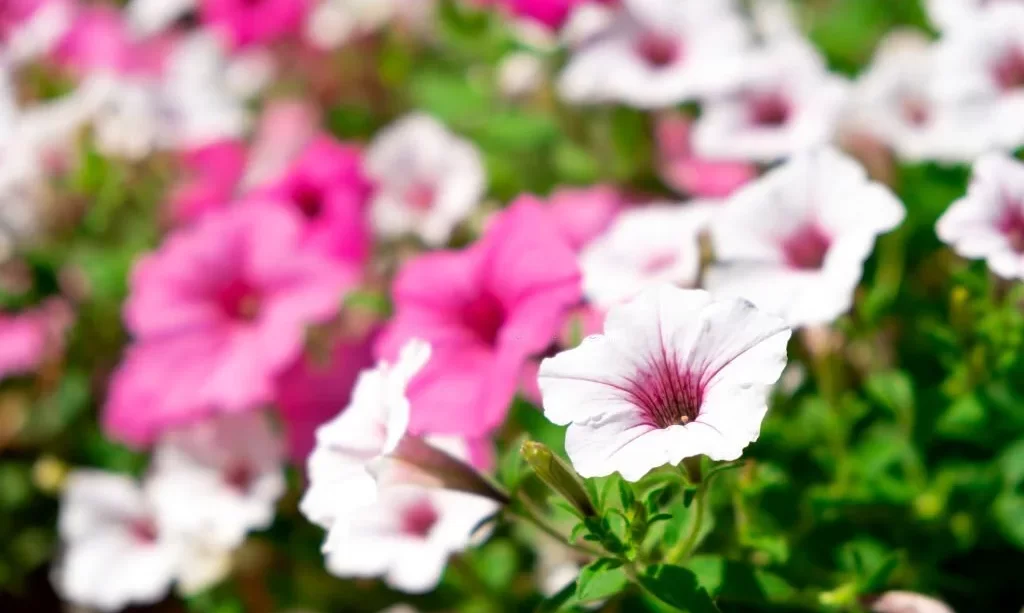When we think of colorful and vibrant flowering plants, petunias often come to mind. Their trumpet-shaped blossoms in a wide range of colors make them a beloved choice for gardens and containers. Traditionally, petunias are known for their preference for full sun, but what if you have a shaded garden or balcony that doesn’t receive hours of direct sunlight? Can you still enjoy the beauty of petunias in these low-light spots? In this guide, we will explore the world of petunias and how they can thrive even in shaded environments. Let’s delve into the art of growing petunias in the shade and discover the possibilities of adding their cheerful blooms to your less sun-kissed spaces.
- Once a bedding plant, suddenly these new spreading types made every hanging basket and window box awash with bold color that just kept coming and coming. Well, now there is an even better Wave—the new Shock Wave series of earlier, more weather resistant, self-cleaning blooms. They begin much sooner in spring, thanks to less day-length sensitivity, and they keep coming all summer and into fall. And the old blooms obligingly drop from the plants, so no more deadheading for you.
- These trumpet-shaped 1½- to 2-inch blooms simply blanket the plant beginning in mid-spring, weeks before other spreading petunias are even setting buds. Reaching 8 to 10 inches high with a very full, mounding shade, these plants spread 2 to 3 feet wide, and keep setting new buds in the center of the plant instead of just at the end of the stems. This way, Shock Wave looks as full and fresh in August as it did in May.
- And the Shock Waves stand up to rain, humidity, heat, and other environmental stresses better than older Waves, bouncing back from summer showers and thunderstorms very well. Compact and very well-branched, they keep their lush, full habit even in the dog days of August, when every other plant around them wilts at noonday and struggles to keep going.
- Now, the one thing Shock Wave needs for its powerhouse blooms is food, so fertilize this plant a bit more heavily than you normally would to keep those flowers coming. Then settle back and enjoy.
- This seed comes as a “pellet”. “Pelleted” seeds are small seeds that have been clay-coated to make them larger and more uniform in size and shape, making them easier to handle when planting.
Petunias
Petunias (Petunia spp.) are members of the Solanaceae family, which includes tomatoes, peppers, and potatoes. Here are some essential points to understand about these versatile and vibrant flowering plants:
- Diversity of Varieties: Petunias come in a wide array of varieties, each offering its unique charm. From compact, bushy forms to trailing or cascading types, petunias can suit various gardening styles and preferences.
- Colorful Blooms: Petunias are renowned for their colorful and eye-catching blossoms. They can be found in nearly every hue imaginable, from classic shades like purple, pink, and white to more unusual colors such as deep blues and vibrant yellows.
- Growing Seasons: Petunias are typically grown as annuals, although some perennial varieties exist. They are prized for their long-lasting flowering period, which often extends from spring through the first frost in fall.
- Sunlight Preference: Traditionally, petunias have been associated with full sun, requiring at least six hours of direct sunlight each day to thrive. This sunlight requirement has led many gardeners to believe that petunias are unsuitable for shaded areas.
However, as we delve deeper into the world of petunias, we’ll discover that there are shade-adapted varieties and strategies to enjoy their beautiful blooms even when sunlight is in short supply.
Can Petunias Grow in Shade?
The traditional wisdom surrounding petunias suggests that they require copious amounts of sunlight to thrive. While it’s true that many petunia varieties prefer full sun, the answer to whether petunias can grow in the shade is a nuanced one. Here’s what you need to know:
- Shade Tolerance: Petunias, by nature, are sun-loving plants. However, some petunia varieties have been bred to be more adaptable, showing increased shade tolerance. These varieties are commonly referred to as “shade petunias” or “petunias for shade”.
- Defining Shade: When considering whether petunias can grow in the shade, it’s essential to clarify what we mean by “shade”. Petunias, even shade-tolerant ones, will not thrive in deep, dense shade where little to no direct sunlight reaches. However, they can adapt to areas with filtered or dappled sunlight, as well as locations that receive a few hours of morning or late afternoon sun.
Selecting the Right Petunia Varieties for Shade
Choosing the appropriate petunia varieties is the key to success when aiming to grow these vibrant blooms in shaded spots:
- Shade-Adapted Varieties: Look for petunia varieties explicitly labeled as shade-tolerant or suitable for partial shade. These varieties have been bred to perform better in lower light conditions.
- Trailing or Cascading Types: Consider trailing or cascading petunia varieties for hanging baskets or container gardening in shaded areas. These varieties are often more adaptable to partial shade and can add a cascade of color to your shady spots.
- Color Preferences: Pay attention to the bloom colors offered by shade-adapted petunia varieties. You can find these petunias in a wide range of hues to suit your garden or design preferences.
- Old Fashioned Vining Petunia Mix
- 100+ seeds, Seeds need light to germinate.
- Shades of White, Pink, Red, Blue, purple and purple/white mix
- Loves sun 2-4 hrs minimum, More sun, more blooms
- Excellent in Hanging baskets, pots, window boxes.
Preparing the Shaded Garden Bed
To create an environment where shade-adapted petunias can thrive, it’s essential to prepare the shaded garden bed:
- Assess Shade Levels: Understand the specific lighting conditions in your shaded area. Determine whether it’s partial shade (some direct sunlight) or dappled shade (sunlight filtered through trees or shrubs). This assessment will help you select the right petunia varieties for your unique conditions.
- Soil Quality: Just like their sun-loving counterparts, petunias in the shade require well-draining soil. Ensure your soil is rich in organic matter, as this will help retain moisture and nutrients, compensating for reduced sunlight.
- Spacing: Follow the spacing recommendations for your chosen petunia varieties. Adequate spacing allows for good air circulation, which can help prevent issues like mildew in shaded areas.
By selecting shade-adapted petunia varieties and carefully preparing the garden bed, you can create a welcoming environment for these beautiful blooms in areas where direct sunlight may be limited.
Planting Petunias in Shade
Planting petunias in shaded areas requires attention to detail and care. Here are the steps to ensure your shade-grown petunias get off to a strong start:
- Select the Right Location: Choose the specific spot in your garden or container that receives the most light within the shaded area. Aim for locations with morning sunlight, as this is generally milder and less intense than the afternoon sun.
- Prepare the Soil: Ensure the soil is well-prepared before planting. It should be loose, well-draining, and enriched with organic matter. This type of soil promotes root development and moisture retention, which can be crucial in shaded settings.
- Spacing and Planting Depth: Follow the spacing guidelines for your chosen petunia varieties. Plant your petunias at the same depth they were in their nursery pots, gently firming the soil around the roots. Adequate spacing prevents overcrowding and allows for good airflow.
- Watering: Water your newly planted petunias thoroughly but avoid overwatering. Shaded areas may retain moisture for longer periods, so it’s essential to monitor soil moisture levels and water only when the top inch of soil feels dry to the touch.
- Ocean Forest organic soil is ready to use right out of the bag
- Ideal for containerized plantings
- Contains earthworm castings, bat guano and micronutrients
- Light texture and well aerated
- Available in 1.5-Cubic feet
Caring for Shade-Grown Petunias
Caring for petunias in shaded areas involves ongoing attention to their needs:
- Moisture Management: Shaded spots can be more prone to excess moisture, which can lead to root rot and other issues. Maintain a consistent watering schedule, ensuring the soil is consistently moist but not waterlogged.
- Mulching: Applying a layer of mulch around your shade-grown petunias can help conserve moisture, regulate soil temperature, and deter weeds. Organic mulch, such as shredded bark or compost, is an excellent choice.
- Pruning and Deadheading: Regularly remove spent flowers (deadheading) and trim back leggy growth. This encourages continuous blooming and a more compact, bushy plant shape.
Fertilizing Shade-Adapted Petunias
To support the growth and blooming of your shade-adapted petunias, consider the following when it comes to fertilization:
- Balanced Fertilizer: Use a balanced, all-purpose fertilizer with equal N-P-K (nitrogen, phosphorus, and potassium) ratios or one slightly higher in phosphorus (the middle number). Phosphorus encourages flowering and root development, which can be beneficial in shaded conditions.
- Fertilizer Frequency: Apply a diluted, balanced fertilizer every 2-4 weeks during the growing season. Follow the package instructions for the correct dilution rate to avoid over-fertilization.
- Avoid Excess Nitrogen: While nitrogen promotes leafy growth, excessive nitrogen can lead to leggy plants with fewer flowers. Balance is key when fertilizing shade-grown petunias.
By carefully following these steps for planting, caring, and fertilizing your shade-adapted petunias, you can enjoy their charming blossoms even in areas with limited sunlight. In the subsequent sections, we’ll explore strategies for dealing with potential pests and diseases and offer guidance on overwintering your shade-loving petunias.
- 20-6-22 Analysis – Great for producing lush green iron dependent annuals in any growing condition.
- Many Ways to Feed – Petunia FeED can be used as a foliar or root feeding product. Great for spraying directly onto leaves, roots, or when used in a continuous feed system.
- Water-Soluble Powder – Powdered concentrates go further than liquid fertilizers. Simply mix your measured powder with water and you are ready to feed with multiple gallons of liquid fertilizer!
- Included Measuring Spoon – All Jack’s Classic fertilizers come with a convenient spoon to create the right amount of liquid fertilizer for your plants.
- Micronutrients – Added micronutrients supply your plant with the nutrition it needs for optimal growth and health. Unlike other fertilizers, additional feeding is not required.
Dealing with Pests and Diseases in Shade-Grown Petunias
Shade-grown petunias can be susceptible to pests and diseases, so vigilance and early intervention are essential:
- Common Pests: Keep an eye out for common garden pests like aphids, slugs, and snails that may thrive in shaded environments. Regularly inspect your petunias and take appropriate measures if you notice any infestations.
- Disease Prevention: Shaded areas may have higher humidity levels, creating conditions conducive to fungal diseases like powdery mildew. To prevent such issues, ensure good air circulation by providing adequate spacing between plants and promptly remove any infected foliage.
- Natural Predators: Encourage natural predators like ladybugs and lacewings in your garden. They can help keep aphid populations in check without resorting to chemical treatments.
Overwintering and Cold Protection
As the colder months approach, it’s essential to consider how to protect your shade-grown petunias:
- Perennial Varieties: If you’ve chosen perennial petunia varieties, they may overwinter successfully in mild climates. Ensure they have adequate mulch to protect their roots from freezing temperatures.
- Annual Varieties: Annual petunias typically won’t survive the winter. Consider taking cuttings or collecting seeds to propagate new plants for the next growing season.
- Container Gardening: If you’re growing petunias in containers, you have the advantage of being able to move them indoors or to a sheltered location during the winter. This can extend their lifespan.
- Covering and Mulching: In areas with occasional light frosts, covering your petunias with a frost cloth or mulching around their base can provide some protection. However, petunias are generally less cold-tolerant than some other plants, so be prepared to replant in the spring.
Conclusion
Growing petunias in shaded areas expands the possibilities for adding their vibrant blooms to your garden, patio, or balcony. While petunias may traditionally prefer full sun, shade-adapted varieties and thoughtful care can help you enjoy their beauty in areas with less sunlight.
In conclusion, remember that the success of shade-grown petunias depends on selecting the right varieties, providing the correct soil conditions, and maintaining appropriate care, including watering, mulching, and fertilizing. Additionally, vigilance against pests and diseases, as well as preparing for colder weather, can help ensure the longevity and vitality of your shade-loving petunias. With a little knowledge and effort, you can brighten up your shaded spaces with the delightful colors of petunias.








